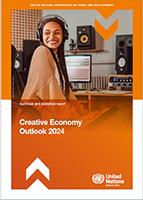
The Creative Economy Outlook 2024 underscores the pivotal role that creative industries play in trade and economic growth. UNCTAD’s global survey reveals the varied economic contributions of the creative economy across different countries, ranging from 0.5% to 7.3% of GDP and employing between 0.5% to 12.5% of the workforce.

The creative economy has the right forces pushing its sails. This is not just art. It is an economic powerhouse that we must harness together, leaving no one behind.
Growth was fastest in creative services
Creative services exports surged to $1.4 trillion in 2022, marking a 29% increase since 2017. Meanwhile, creative goods exports reached $713 billion, a 19% increase. Over the past decade, creative services' share of all service exports rose from 12% to 19%, while creative goods' share of all goods exports has remained steady around 3% since 2002. Developing countries primarily export creative goods, while developed countries dominate creative services exports. However, developing countries have significantly increased their share from 10% in 2010 to 20% in 2022.
The most exported creative services in 2022 were software services (41.3%) and research and development (30.7%), followed by advertising, market research, and architecture (15.5%), audiovisual services (7.9%), information services (4%), and cultural, recreational, and heritage services (0.6%).
Digital transformation in creative industries
Digitalization is transforming the creative economy. For example, streaming services expanded their share of the global music market by 10.4% year-on-year, and now account for 67.3% of global music revenue streams. AI is a key driver of this change, enhancing content creation, distribution and consumption. It generates scripts, movies, news articles, music, images, captions, animations and virtual reality content, while improving post-production workflows and analyzing user data.
AI is widely used in newsrooms, with 41% of news teams employing it to create illustrative art, 39% for social media content, and 38% for writing and generating articles. Digital tools lower costs and expand revenue opportunities, making global markets more accessible for individual creators. However, they also bring challenges such as quality control, copyright issues, privacy concerns, and market monopolization. Robust regulatory frameworks are necessary to ensure these technologies benefit everyone and foster a competitive creative economy.
Growing market concentration threatens innovation
Market concentration poses significant challenges to the creative economy. Dominant players can stifle innovation and limit opportunities for smaller firms. For instance, in the USA, the "Big Five" publishers hold about 80% of the book market, while six movie studios account for nearly 90% of box office ticket sales in recent years. In 2021, three companies dominated 59% of the global streaming music subscription market.
Effective policies in some countries have fostered thriving creative sectors by protecting intellectual property and ensuring competitive markets. The report emphasizes the need for a level playing field to promote a diverse and vibrant creative economy.
Embracing inclusion and sustainability
Inclusion and environmental sustainability are becoming a cornerstone of the creative economy. A headline example was Coldplay cutting its recent global tour’s CO2 emissions by 50%, showcasing efforts to reduce the environmental impact of large-scale events.
Governments are integrating inclusion and environmental sustainability into policies targeting the creative economy. Twelve out of 36 countries surveyed have specific initiatives for creative industries, while another twelve promote sustainable business practices, including sustainable design, energy efficiency, circular economy practices, and increasing the participation of women, youth and disadvantaged groups.





